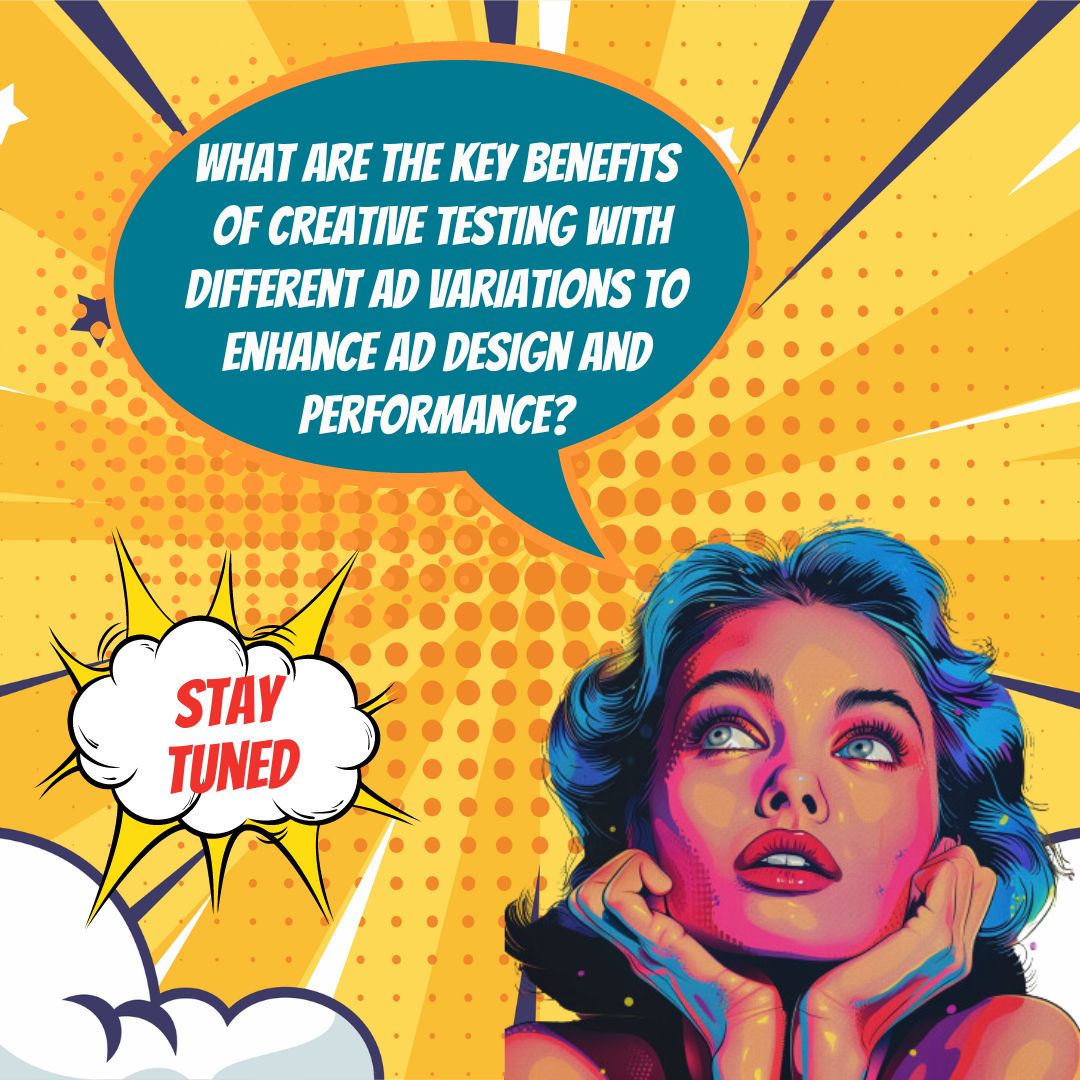Key Takeaways
✅ Identifying High-Performing Elements: Creative testing with ad variations allows businesses to experiment with different headlines, visuals, and calls-to-action. By comparing performance metrics, companies can identify which elements resonate most with their audience, leading to more effective and engaging ad designs that drive better results.
✅ Enhanced Audience Engagement: Testing various ad creatives helps businesses understand what captures their audience's attention and encourages interaction. By optimizing design elements based on test results, ads become more compelling and relevant, resulting in higher engagement rates and improved overall campaign performance.
✅ Continuous Improvement and Innovation: Creative testing fosters a culture of continuous improvement and innovation. Regularly experimenting with new ideas and designs ensures that ads stay fresh and relevant, adapting to changing consumer preferences and market trends, ultimately leading to sustained growth and success in advertising efforts.

Introduction
Have you ever wondered how some advertisements seem to capture your attention more effectively than others? The secret often lies in creative testing—a crucial strategy to optimize ad designs for maximum impact. This process involves experimenting with multiple ad variations to discern what resonates best with your target audience, enabling you to make data-driven decisions that can dramatically enhance your campaign performance.
As we dive into the world of ad variations and creative testing, we'll explore the vital role these strategies play in boosting not only engagement but also the overall return on investment (ROI) for your marketing efforts. Keep reading to discover actionable insights and innovative perspectives that could redefine your approach to ad design. Get ready to turn the gears of creativity and strategic innovation in your marketing campaigns!
Top Statistics
| Statistic | Insight |
|---|---|
| Importance of Creative Optimization: According to Adobe, 62% of marketers believe that creative optimization is critical to driving brand performance, and 76% plan to increase their investment in this area. (Source: Adobe, 2020) | This statistic emphasizes the growing recognition of innovative design as a key driver in brand performance and market competitiveness. |
| Campaign Performance Increase: Creative testing can lead to a 30% increase in campaign performance, as found by Facebook. (Source: Facebook, 2019) | Highlighting the direct benefit of ad variations, this data point showcases how creativity leads to tangible results in engagement and conversions. |
| Consumer Expectations: 66% of consumers expect brands to understand their unique needs, says Google. (Source: Google, 2019) | The statistic underlines the importance of using creative testing to tailor ad experiences that resonate with individual consumer preferences and consumer expectations. |
| AI Integration in Creative Testing: Gartner predicts that by 2023, 50% of large organizations will use AI-based creative testing. (Source: Gartner, 2020) | This forecast points towards the increasingly crucial role of AI in optimizing and personalizing the digital customer experiences through intelligent creative testing. |
The Importance of Creative Testing in Ad Design
Creative testing holds a pivotal role in the realm of advertising, primarily serving as a method to determine which ad variations perform best before a full-scale campaign launch. This approach not only enhances the effectiveness of advertisements but also optimizes marketing budgets by allocating resources to the most successful ads. Benefits include increased engagement rates, higher conversion, and overall better ROI. By effectively testing creative elements, advertisers can refine their messaging and visuals to best meet the audience's interests and needs.
Understanding Ad Variations
Ad variations lie at the heart of creative testing, involving changes in visuals, copy, targeting, and placement to evaluate which combination yields the best results. Each variation can significantly affect the ad's performance by appealing differently to the target audience. For instance, changing a headline or using a different image can lead to a noticeable difference in user engagement and conversion rates. Understanding which type of variation affects performance the most can help marketers focus their efforts more effectively.
Setting Up a Creative Testing Strategy
When setting up a creative testing strategy, it's crucial to determine clear objectives and KPIs (Key Performance Indicators) according to what success looks like for a particular campaign. Choosing the right ad platform and identifying the appropriate audience segment are equally important to ensure that the data collected is relevant and actionable. Methods such as A/B testing, multivariate testing, or split testing can be utilized, depending on the campaign's complexity and the specific elements being tested.

Creating and Launching Ad Variations
Designing impactful ad variations requires adherence to best practices such as maintaining brand consistency, enhancing brand recognition, and incorporating elements that capture attention. Writing effective ad copy should be concise, persuasive, and directly relevant to the target audience. Once these variations are developed, launching and closely monitoring their performance is critical to gather meaningful data and insights.
Analyzing and Interinterpreting Test Results
The analysis phase is vital in creative testing. It involves collecting, sorting, and interpreting data garnered from different ad variations. Marketers need to determine which variations achieved the highest performance metrics and more importantly, understand the reasons behind their success. This might involve deep dives into analytics to ascertain details like click-through rates, conversion rates, and engagement levels. Calculating the impact of these variations on overall ad performance helps in making informed decisions.
Implementing and Refining Ad Design
After identifying the most effective ad variations, the next step is integrating these successful elements into the larger ad campaign. This is not a one-time task but a continuous process where ongoing refinement based on test results and audience feedback is essential. It also includes translating the learnings obtained from the testing phase into actionable insights for future campaigns, ensuring that each iteration is more aligned with the audience's preferences and behaviors.
Creative testing is not just a tactic, but a strategic component of advertising that ensures every ad dollar spent is done so with precision and purpose. By continuously embedding this process into your advertising efforts, you can ensure that your ads not only resonate with your target audience but also deliver on your marketing objectives effectively.

AI Marketing Engineers Recommendation
Recommendation 1: Utilize A/B Testing for Instant Feedback: By systematically comparing two versions of an ad (A and B) and measuring the difference in performance, businesses can gather immediate, actionable data on what visuals, messages, or formats resonate best with their audience. For instance, a statistic from VWO indicates that A/B testing can increase conversion rates by up to 49% in some industries. How Can Creative Testing with Ad Variations Optimize Design? By allowing marketers to refine their ad elements based on concrete evidence of what performs better, thereby enhancing overall ad effectiveness.
Recommendation 2: Implement Dynamic Creative Optimization (DCO): This strategy uses algorithms to automatically adjust and personalize advertising content in real-time to suit individual viewer preferences. This method is especially effective due to its capacity to respond to user behavior and environmental changes swiftly. According to a report from AdWeek, ads utilizing DCO see up to a 50% increase in engagement compared to static ads. How Can Creative Testing with Ad Variations Optimize Design? By maximizing the relevance of the ad to each viewer, thereby improving the likelihood of achieving marketing goals.
Recommendation 3: Adopt Predictive Analytics Tools: These tools use data, statistical algorithms, and machine learning techniques to identify the likelihood of future outcomes based on historical data. Tools like Google Analytics Predictive Audiences allow marketers to use past performance data to anticipate which designs and messages are most likely to succeed. How Can Creative Testing with Ad Variations Optimize Design? By using past success patterns to forecast and enact more effective future campaigns, thus ensuring resources are correctly allocated towards the most impactful designs.
Relevant Links
- Revolutionize Your Digital Marketing with AI
- Unleash AI's Power for Small Business Growth
- Mastering AI in 2024 E-commerce: Strategies for Success
- Navigating the Future of Marketing with AI Analytics
- Elevating Sales with Innovative Marketing Strategies
Conclusion
In the ever-evolving landscape of digital advertising, the importance of creative testing cannot be overstated. Through implementing ad variations, marketers can decisively pinpoint what resonates best with their audience, ensuring that every ad dollar is spent efficiently. But why settle for a one-size-fits-all approach when you can optimize?
Creative testing, particularly through the use of ad variations, offers a robust method to enhance ad design and overall campaign performance. By systematically tweaking elements like visuals, copy, and placement, and evaluating results through rigorous methods such as A/B testing or multivariate testing, businesses gain invaluable insights. These insights not only highlight which variations perform best but also why they outperform others, enabling marketers to make data-driven decisions.
However, the journey doesn't end with identifying the winning ad variation. The true power of creative testing lies in its cyclical nature—launch, test, analyze, and refine. By continuously integrating winning elements into new ad campaigns and refining them based on consumer feedback and changing market conditions, businesses can maintain a competitive edge.
Given these benefits, integrating creative testing into your regular marketing activities can seem more like an imperative rather than an option. Are you leveraging the full potential of ad design optimization in your campaigns? If not, perhaps now is the time to start.
Remember, in the realm of digital marketing, stagnation equates to regression. Continuous optimization is your ladder to staying relevant, resonant, and successful in capturing your audience's attention. So why not climb that ladder with every campaign you create?

FAQs
Question 1: What is creative testing with ad variations?
Answer: Creative testing with ad variations involves experimenting with different visual and textual elements in advertisements to determine which combinations perform best in terms of engagement, clicks, and conversions.
Question 2: Why is creative testing important for ad optimization?
Answer: Creative testing is essential for ad optimization because it helps identify the most effective ad designs, messaging, and calls-to-action, leading to improved performance, higher ROI, and better user experiences.
Question 3: What are the key elements to test in ad variations?
Answer: Key elements to test in ad variations include headlines, imagery, color schemes, ad copy, call-to-action (CTA) buttons, target audience, and ad placements.
Question 4: How can I set up a creative testing strategy?
Answer: To set up a creative testing strategy, define your goals, choose the elements to test, create variations, determine the testing method (A/B testing, multivariate testing, or split testing), establish a testing schedule, and analyze the results to make data-driven decisions.
Question 5: What are the best practices for creative testing?
Answer: Best practices for creative testing include testing one element at a time, keeping the testing period short, using statistical significance to determine winners, and ensuring that the test results are not influenced by external factors (e.g., seasonality, market trends).
Question 6: How can I use creative testing for social media ads?
Answer: To use creative testing for social media ads, follow the same principles as other ad formats, but also consider the unique features of each platform (e.g., Instagram's focus on visuals, Twitter's character limit).
Question 7: What is A/B testing, and how does it apply to creative testing?
Answer: A/B testing is a method of comparing two versions of an ad (A and B) to determine which performs better. In creative testing, A/B testing can be used to compare different ad elements, such as headlines or imagery.
Question 8: How can I use creative testing to improve my landing pages?
Answer: You can use creative testing to improve landing pages by testing different versions of headlines, hero images, CTAs, and overall page layouts. This can help you optimize the user experience and increase conversion rates.
Question 9: What are some common mistakes to avoid when conducting creative testing?
Answer: Common mistakes to avoid when conducting creative testing include testing too many elements at once, running tests for too long, not having a clear hypothesis, and not considering external factors that could influence the results.
Question 10: How can I use creative testing to improve my video ads?
Answer: To improve video ads through creative testing, test different video lengths, thumbnail images, intro sequences, and CTAs. Also, consider testing different ad placements and targeting options to reach the right audience.


